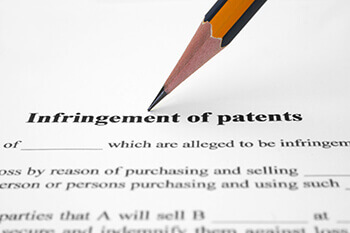Intellectual Property Law
Common Defenses to Patent Infringement
The common defenses to patent infringement include:
Invalidity: The patent in question is invalid as obvious or anticipated by prior art. Every patent is assumed to be valid based on the USPTO examination before it is awarded. Therefore, to invalidate a patent as obvious or anticipated requires convincing and clear evidence that prior art already exists.
Inequitable conduct: A defense of inequitable conduct asserts:
- The patent owner misled the examiner on purpose
- The patent owner withheld information they knew was important
- The patent is not valid, and no infringement can be had
- Honesty rules of some kind were broken
First Sale Doctrine: You are reselling an item legally sold to you. This defense is available because patent rights exhaust on a specific item once that item is sold.
Repair Doctrine: You are repairing a device by replacing components that are not patented. This defense does not permit you to completely rebuild an invention.
Patent misuse: The following examples are considered misuse of a patent:
- Using it to violate antitrust
- Using it to crush competition
- Using it to engage in business practices that are unethical, such as price fixing
Licensing: The patent holder granted permission or rights to use the patent to you and you have used the invention in compliance with said rights or permission.
Patent Exhaustion: The accused’s supplier upstream has legally purchased the patented invention from either the patent holder or a licensee of the same. Current laws forbid a patent holder from attempting to collect payment from multiple levels of a supply chain for a single patented invention.
Estoppel: There are two forms of estoppel:
- File Wrapper Estoppel: If the inventor disclaimed rights or admitted to any limitations of rights in their patent application, those disclaimed rights cannot be used as part of a patent infringement case.
- Equitable Estoppel: The patent holder led you to believe that there would be no enforcement of the patent. This can occur either from promises or failure to enforce. It means that the accused counted on that belief or assurances in continuing their business practices.
Experimental use: You can use a patent invention if it is related to the development of information. You can also use it if it is related to the submission of the same under Federal laws regulating the use, sale, and manufacture of drugs.

Catherine Rajwani
Principal Attorney
PHONE: 508-393-9244
EMAIL: crajwani@harborlaw.com
Catherine Rajwani is an intellectual property and business litigation attorney.
Ms. Rajwani handles a full range of intellectual property and business issues in her practice including patent, trademark, copyright, trade secret, contract and business tort disputes. She has participated in all phases of litigation, from pre-litigation counseling through trial and appeal, in federal courts throughout the country. She is also skilled in alternative dispute resolution proceedings.
Find out more about issues in our related practice areas
Intellectual Property Law
Trademark Protection
Trade Secrets
Copyrights
Patents
Intellectual Property Law
Insights, opinions and decisions you should know about

Defend Trade Secrets Act: Two Years Later
It has been more than two years since President Obama signed the Defend Trade Secrets Act (DTSA) into law, which created a federal, private, civil cause of action for trade-secret misappropriation in which “[a]n owner of a trade secret that is misappropriated may...

Where Do You Sue for Patent Infringement? – Proper Venue Post ‘TC Heartland’
In May of 2017, the Supreme Court unanimously reversed the Federal Circuit’s 25-year-old precedent on venue for corporate defendants.[1] Venue is the proper or most convenient location for trial of a case, and is governed by state and federal statutes. The 10-page...

Cost-Effective Mechanisms for Enforcing Intellectual Property Rights
In my practice, I counsel small and midsize business clients, many of which are astute with regard to securing their intellectual property rights. They have federally registered their trademarks with the U.S. Patent and Trademark Office, secured a portfolio of patents...

How Do I Defend a Patent Lawsuit?
The Top 5 Ways to Defend Your Company in Patent Infringement Litigation You discover that your company has been sued for patent infringement. After reviewing the patent cited in the complaint, you determine that the technology described relates to your company’s...
Get in touch with us.
Learn more about how we can help.